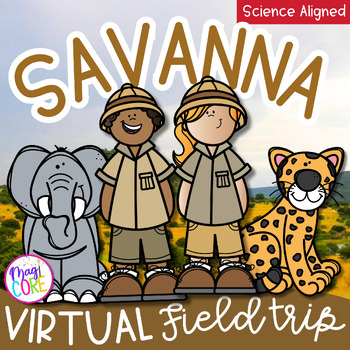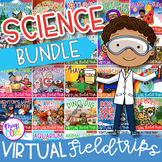Virtual Field Trip Africa Savanna Grassland Habitat Digital Resource Activities

What educators are saying
Also included in
- ⭐️Let's all take a field trip! This GROWING bundle contains a variety of virtual field trips suitable for 2nd - 5th grade students. Students visit New York City, go on a safari in the African savanna, accompany paleontologists on a dinosaur dig, and much more. There are over 80 destinations and morePrice $219.50Original Price $340.25Save $120.75
- ⭐️Let's all take a field trip! This GROWING bundle contains a variety of science-based virtual field trips suitable for 2nd - 5th grade students. All field trips incorporate NGSS standards. Students go storm chasing, go on a safari in the African savanna, accompany paleontologists on a dinosaur dig,Price $79.50Original Price $94.50Save $15.00
Description
⭐️Let's all take a field trip! In this Virtual Field Trip, students learn all about the African Savanna. This virtual field trip contains video links, images, passages, and more. Students read about the savanna and experience the different plants and animals through multimedia and YouTube links.
⭐️This resource integrates a variety of skills. Students complete reading and writing assignments along with watching videos and completing activities like comparing and contrasting. Incorporates key reading comprehension, writing, multimedia, science, and other skills.
Aligns to NGSS Standards:
NGSS3-LS4-4 : Make a claim about the merit of a solution to a problem caused when the environment changes and the types of plants and animals that live there may change. Examples of environmental changes could include changes in land characteristics, water distribution, temperature, food, and other organisms. Assessment is limited to a single environmental change. Assessment does not include the greenhouse effect or climate change.
NGSS2-LS4-1: Make observations of plants and animals to compare the diversity of life in different habitats. Emphasis is on the diversity of living things in each of a variety of different habitats. Assessment does not include specific animal and plant names in specific habitats.
NGSS3-LS4-3: Construct an argument with evidence that in a particular habitat some organisms can survive well, some survive less well, and some cannot survive at all. Examples of evidence could include needs and characteristics of the organisms and habitats involved. The organisms and their habitat make up a system in which the parts depend on each other.
NGSS3-LS2-1: Construct an argument that some animals form groups that help members survive.
*Please note: This resource includes links to YouTube videos, so ensure you and your students have access to YouTube before purchasing. Although great care has been taken to ensure all content is appropriate for the stated grade levels, each classroom is unique and it is recommended that teachers review all content prior to use. I recommend embedding the videos to avoid ads and other content that may be inappropriate. Instructions for embedding the videos are included and it should only take a few minutes. Also, keep in mind that any links to third-party content may be changed or removed by the content owner. All links are reviewed regularly; however, if you find a broken link, please let me know so I can update the resource accordingly.
Features:
✏️Google Slides Format - This interactive format is perfect for distance learning. Slides are interactive and can be used as a fun and engaging exercise within the classroom or remotely.
✏️Virtual Video Tours - Video tours of that take students inside the action.
✏️Reading Comprehension - Integrates key reading skills like compare & contrast, multimedia, multiple sources, and more.
✏️Writing & Science - Virtual field trip helps students understand more about the world around them and uses writing prompts to explore their reactions and ideas.
What's Included?
- What Is A Savanna?
- Where Are Savannas?
- Write a Journal Entry
- Plants of the Savanna
- Animals of the Savanna
- African Lions
- African Elephants
- Zebras
- Cheetahs
- Compare & Contrast
- Animal Groups
- Write a Journal Entry
- Savannas at Risk
- Cause and Effect
- Brainstorm
*Answer Key Included
This resource is suitable for the following grade levels:
- 2nd & 3rd Grade: With teacher modeling, whole class, or small groups.
- 4th & 5th Grade: Independent for on-level students.
Time to Complete:
This virtual field trip takes approximately 45 minutes to 1 hour to complete. The time it takes to complete can vary based on your students. It can be completed in one session or broken up into multiple sessions.
Copyright & Terms of Use:
For copyright information and a summary of how this resource can and cannot be used, please review the Terms of Use Page.
***************************************************************************
Customer Tips:
How to get TPT credit to use on future purchases:
- Please go to your My Purchases page (you may need to login). Beside each purchase, you'll see a Provide Feedback button. Simply click it and you will be taken to a page where you can give a quick rating and leave a short comment on the product. Each time you give feedback, TPT gives you feedback credits that you use to lower the cost of your future purchases. I value your feedback greatly as it helps me determine which products are most valuable for your classroom so I can create more for you. ☺
Be the first to know about my new discounts, freebies, and product launches:
- Look for the green star next to my store logo and click it to become a follower. Voila! You will now receive email updates about this store. ☺
- Follow me on Facebook for updates on new products and sales
- Follow me on Instagram
- Join my email list by visiting my website and receive a free resource
*****************************************************************************







